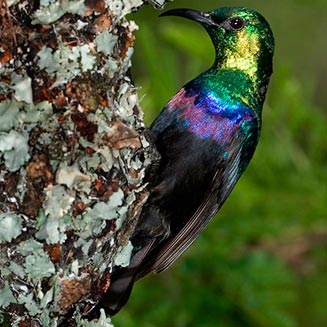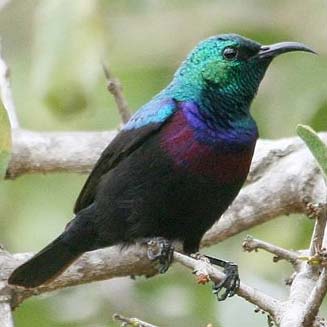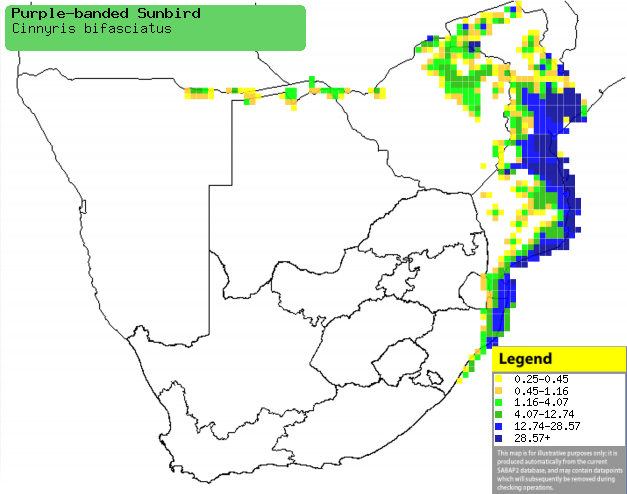|
Cinnyris bifasciatus
(Purple-banded sunbird)
[= Nectarinia bifasciata]
Purperbandsuikerbekkie [Afrikaans]; Kalyambya (generic term for
sunbird) [Kwangali]; Dzonya, Tsodzo (both are generic names for sunbird)
[Shona]; Purperband-honingzuiger [Dutch]; Souimanga bifasciť [French]; Kleiner
bindennektarvogel [German]; Beija-flor-de-peito-roxo [Portuguese]
Life
> Eukaryotes >
Opisthokonta
> Metazoa (animals) >
Bilateria >
Deuterostomia > Chordata >
Craniata > Vertebrata (vertebrates) > Gnathostomata (jawed
vertebrates) > Teleostomi (teleost fish) > Osteichthyes (bony fish) > Class:
Sarcopterygii (lobe-finned
fish) > Stegocephalia (terrestrial
vertebrates) > Tetrapoda
(four-legged vertebrates) > Reptiliomorpha > Amniota >
Reptilia (reptiles) >
Romeriida > Diapsida > Archosauromorpha > Archosauria >
Dinosauria
(dinosaurs) > Saurischia > Theropoda (bipedal predatory dinosaurs) >
Coelurosauria > Maniraptora > Aves
(birds) >
Order: Passeriformes > Family: Nectariniidae
 |
 |
|
Purple-banded sunbird, Krantzkloof Nature Reserve,
KwaZulu-Natal. [photo Hugh Chittenden ©] |
Purple-banded sunbird, Ngwenya Resort, Mpumalanga,
South Africa. [photo Alan Manson
©] |
For information about this species, see
www.birdforum.net/opus/Purple-banded_Sunbird
Distribution and habitat
Occurs in localised patches from southern Somalia through
to Uganda, southern DRC, Zambia, Angola, Malawi and southern Africa. Here it is
locally common from Mozambique to KwaZulu-Natal, but scarce further west in
Zimbabwe, northern Botswana and the Caprivi Strip, Namibia. It generally prefers
coastal bush habitats, such as mangroves and edges of lowland evergreen forest,
further inland occupying riverine forest, thickets and occasionally well-wooded
gardens.
|
 |
|
Distribution of Purple-banded sunbird in southern Africa,
based on statistical smoothing of the records from first SA Bird Atlas
Project (©
Animal Demography unit, University of
Cape Town; smoothing by Birgit Erni and Francesca Little). Colours range
from dark blue (most common) through to yellow (least common).
See here for the latest distribution
from the SABAP2. |
Predators and parasites
It has been recorded as host of the following blood
parasites:
- Leucocytozoon nectariniae
- Trypanosoma
Food
It mainly feeds on nectar supplemented with small
arthropods, doing most of its foraging in the heat of the day, when the flowers
are open. The following food items have been recorded
in its diet:
- Nectar
- Loranthaceae (mistletoes)
- Syzygium (waterberries)
- Aloe
- A. arborescens (Krantz aloe)
- Leonotis (wild dagga)
- Mimusops caffra (Coastal red-millkwood)
- Eucalyptus
- Arthropods
Breeding
- The nest is built solely by the female, consisting of a tidy, pear-shaped
oval with a side entrance, built mainly of petioles and lichen bound with
spider web, sometimes along with dry grass, plant fibres, leaves and fronds.
A long tail of material hangs from the base of the structure, which is
decorated with wood chips, lichen, caterpillar droppings and seeds, while
the interior is lined with vegetable down and feathers. It is typically
attached at the roof to a twig, creeper, small branch or bamboo, often
overlooking water, a dry riverbed or roadway.
- Egg-laying season is from August-March, peaking from September-October.
- It lays 1-2, rarely 3 eggs, which are incubated solely by the female.
- Little is known about the chicks, other than that they are fed by both
parents.
Threats
Not threatened.
References
-
Hockey PAR, Dean WRJ and Ryan PG 2005. Roberts
- Birds of southern Africa, VIIth ed. The Trustees of the John Voelcker
Bird Book Fund, Cape Town.
|
